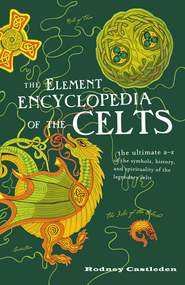
Полная версия:
The Element Encyclopedia of the Celts
More arresting still, the accoutrements of the warrior-princes were elaborately decorated with what we now see as typical Celtic designs. The La Tène style is familiar to us: it is the root of all the later artwork that we recognize as Celtic. The S-shaped line that endlessly repeats suggests a variety of things, including rippling water and plant tendrils. But there are also surprises. In the middle of a swirl of lines we sometimes recognize an animal head, so stylized that we cannot be sure whether it is really there, intended by the artist-craftsman, or we ourselves are projecting it—like the giants or mountain landscapes we sometimes see in cloud formations. And here is a hint of the Celtic love of shapeshifting legends.
According to the threefold model for Iron Age Britain, a third wave of innovation came with a third lot of migrants, the Belgae, who arrived in south-east England late in the first century BC. The Belgic culture area extended from Belgium across northern France into south-east England. Distinctive objects associated with the Belgae in Britain were wheel-made pottery and Gallo-Belgic coins.
But this threefold model has been shaken by the general acceptance that there were no mass movements of people into Britain in the first millennium BC. There were no invasions, apart from Julius Caesar’s; instead we should think rather of a complex evolution of an indigenous culture.
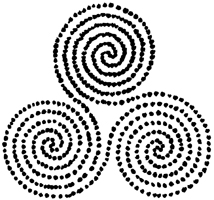
CUNOBELIN
King of the Catuvellauni tribe, son of Tasciovanus, and grandson or great-grandson of Cassivellaunus. He was the successor of Dubnovellaunus, King of the Trinovantes, the Catuvellauni’s eastern neighbors, when he died in about AD 10. Dubnovellaunus had fled to Rome, taking refuge at the court of Augustus when the Catuvellauni had annexed his territory and had no doubt been hoping that the emperor would intervene on his behalf. Cunobelin anticipated trouble from Rome and prudently became a Roman ally. As a client king he could expect favorable treatment from Augustus.
Cunobelin was a strong ruler and under his leadership the old imposed alliance between the Catuvellauni and the Trinovantes was re-asserted. This expanded kingdom was undoubtedly the strongest political entity in Britain on the eve of the invasion by the emperor Claudius in AD 43, and the Roman historian Suetonius described Cunobelin as “King of Britain.”
Cunobelin ruled the large joint kingdom from Camulodunum, near modern Colchester, which was previously the chief settlement of the Trinovantes. This move appears to have been made in order to tap into the European trading network more easily.
Camulodunum was a large urban complex covering 12 square miles (30 square km) and marked out by flanking rivers and big earth ramparts. It was a major industrial focus that included a mint. At Gosbecks there was a massive concentration of expensive imported pottery in one area, which was probably Cunobelin’s palace. Nearby there was a royal burial ground.
Cunobelin and his court were Romanized Celts. They were native Britons, but they were also keen to acquire all the luxury goods they could from Rome. They may have adopted Latin; some Latin graffiti have been found, though they could have been inscribed by Roman visitors. The Catuvellaunian aristocrats were in effect being bought or groomed by Rome in advance of the Claudian invasion. Having some client kings in Britain made invasion and annexation much easier.
Strabo observed that certain British kings “procured the friendship of Caesar Augustus by sending embassies and paying court to him.”
Cunobelin is the original of Shakespeare’s Cymbeline, and the only pre-Roman chief to be remembered in later times. Shakespeare’s portrayal of Cymbeline bears little relation to history, except for the idea that a client king was expected to pay annual tribute to Rome and that he found this hard to suffer:
…Britain is
A world by itself, and we will
nothing pay
For wearing our own noses.
The Lexden Tumulus in Colchester may be the grave of Addedomarus or of Cunobelin. It is about the right date to be Cunobelin’s, and of the right status. It contained chain-mail armor, Roman bronzes, furniture, and 15 wine amphorae. The bronze ornaments in the grave date from the eve of the invasion by Claudius. One of the grave goods is a pendant made out of a silver coin with a fine portrait bust of the young Augustus on it (see Places: Lexden Tumulus).
Cunobelin may have worn the pendant: he saw himself as the British Augustus. On his own coins he had the portrait of Augustus imitated and labelled CVNO.
After Cunobelinus’s death, his two sons, Togodumnus and Caratacus, expanded Catuvellaunian power even more aggressively than their father. They seemed to be fearless of the Romans hesitating to invade on the other side of the Channel.
CURSE TABLETS
Romano-Celtic curses inscribed informally on sheets of lead are known by the Latin name defixiones, because of the form of words often used: somebody’s name followed by defictus est (“is cursed.”) They were deposited with other offerings in shrines. In effect the curse was offered up to the gods just like any other prayer.
In 1930 only four curse tablets were known, but subsequent excavations, at places such as Bath, and Uley in Gloucestershire, have revealed many more of them. They are difficult to read because they have been hastily scratched.
Curse tablets are of interest in their intensely personal character. A fine example was found at the Romano-Celtic sanctuary at Uley. It was written on both sides of a rectangular lead sheet 3.5 inches (9cm) across and then rolled up tightly, presumably so that no one except the god would be able to read it. When it was found, it had to be unrolled very carefully under laboratory conditions, to make sure that it did not break up. The conservation was successful, and this is how the inscription runs:
A reminder to the God Mercury from Saturnina, a woman, concerning the linen cloth she has lost. Let him who has stolen it have no rest until he brings the aforesaid things to the aforesaid temple, whether this is a man or a woman, slave or free. She gives a third part to the aforesaid god on condition that he exacts those things which have been written above. A third part of what has been lost is given to the god Silvanus on condition that he exact this whether [the culprit?] is a man or woman, slave or free.
This curse was left at the shrine, where a fine stone statue of Mercury presided; its head has survived. Where Saturnina wrote the name of the god Mercury, the name of another god, Mars-Silvanus, has been erased. The later reference to Silvanus confirms that the woman was depositing her curse with two gods, not just one, as an insurance. It also looks as if she had left a curse with Mercury before: this is “a reminder.” Whether Saturnina ever got her linen back we shall never know.
Some tablets sound more legalistic. One from Bath reads: “I have given the goddess Sulis six silver pieces which I have lost. It is for the goddess to extract it from the debtors Senicianus, Saturninus, and Anniola. This document has been copied.”
Some are difficult to translate because they have been written informally and ungrammatically, apparently in a rage. One of these, again from Bath, reads: “I curse whoever has stolen, whoever has robbed Deomorix from his house. Whoever is guilty may the god find him. Let him recover it with his blood and his life.” Deomorix was a Celt.
A tablet from Moorgate in London was written in a towering rage: “I curse Tretia Maria and her life and mind and memory and liver and lungs all mixed up together, her words, thoughts and memory, thus may she be unable to speak of things concealed…”
One from Harlow, addressed to Mercury, is not about theft—which most are—but about a love triangle: “I entrust to you my affair with Eterna and her own self, and may Timotneus feel no jealousy of me at risk of his life blood.”
CYNLAS
See Ewein Whitetooth.

DAVID
David or Dewi of Menevia (St. David’s) was probably born in 523. He died in 589. He was the son of “Sanctus,” King of Cardigan, and Nonnita, daughter of Cynyr, “in the time of King Triphunus and his sons.” He was baptized by Ailbe and educated at Vetus Rubus (Henllwyn) under Illtud. After a time he established Vallis Rosina (Hodnant, now called Merry Vale). David was harassed by an Irish chief called Boya, who paraded naked women in front of his monks in order to tempt them. He established an austere monastic rule, living on vegetables and water, which earned him the nickname David Aquaticus. Gildas denounced his extremism.
At the Synod of Brefi, in about 545, called to discuss Pelagianism, David addressed the assembly and his oratory persuaded them, much to the anger of Cadoc, who was then overseas. But this synod was a decisive victory for David. New monastic houses were founded all over the country and David was informally acclaimed archbishop or even “head” of all Britain.
One notable disciple was Aedan of Ferns, and through him up to one third of Ireland followed David’s rule. David’s name recurs frequently in the Lives of Irish Saints.
The cult of David spread widely in Demetia (Pembrokeshire), Brecon, and the Wye Valley. It was more scattered in Cornwall and Brittany, was never established in Glamorgan, where Cadoc and Illtud held sway, and was absent from Scotland.
DECEANGLI
A British tribe living in North Wales, in what is now Clwyd.
DECIANUS CATUS
See Boudicca.
DEWI
See David.
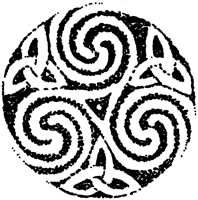
DIARMAIT
See Columba of Iona, Ruadan.
DICUL
An Irish abbot who set up a small monastic house at Bosham, in Sussex, in around 650. He had with him five or six monks and they apparently had no effect at all on the local (pagan Saxon) population. St. Wilfrid found them there when he arrived in 680.
DIODORUS SICULUS
A Greek historian who lived in the first century BC. He was born in Sicily and later lived in Rome, where he collected the materials for his huge history of the world in 40 books. Some of our most reliable information about the state of Europe in the late Iron Age, not least about the Celts, comes from Diodorus.
DIVICIACUS
A Druid of whom Julius Caesar had personal knowledge. As well as being a Druid, Diviciacus was chief of the Aedui tribe and brother of Dumnorix. He went on a diplomatic mission to Rome, where he got to know Cicero, who described how Diviciacus would predict the future by augury. Cicero referred to him as a Druid.
Diviciacus helped Caesar enormously in his conquest of Gaul by persuading some of the tribes to collaborate with Rome. Caesar depended on him to form alliances that enabled him to conquer Gaul more smoothly and rapidly.
Caesar must have known that Diviciacus was a Druid, yet he does not mention it. But he did remember him as “the greatest man in Gaul”—a leader who had held sway among Gallic tribes and was also influential in Britain.
DOCCO
Also known as Kyngar of Congresbury, Docco was the son of Luciria and the emperor Constatinus III. He was born in 400–10. He was a cleric who traveled from Italy to found several major early monastic houses in Britain, including Congresbury in Somerset. The site was on the estate of a Roman villa, though the villa itself had by then gone.
Docco also crossed the Severn Sea to Glamorgan to found a monastery in the territory of Paulentus Penychen and visited Ireland, Aran, Rome, and Jerusalem. His monastery at St. Kew is the earliest known Cornish monastery—it was already well-established when St. Samson visited it in 540.
Docco died in Jerusalem in 473 and his body was buried at Congresbury.
Docco, David, and Gildas are the only British churchmen to be mentioned in the Irish Annals.
DRESS
In the first century BC, Posidonius wrote this colorful description of the Celts:
To the frankness and high-spiritedness of their temperament must be added the traits of childish boastfulness and love of decoration. They wear ornaments of gold, torcs on their necks, and bracelets on their arms and wrists, whilst people of high rank wear dyed garments besprinkled with gold.
The torc was a neck ring that was a mark of status of freeborn Celtic men (and sometimes women). Rich people wore gold torcs, which were flexible enough to be bent and sprung back around the wearer’s neck. Poorer people wore torcs of iron or bronze, which had movable sections that could be pegged into place. The huge difference in wealth between rich and poor is clear from the finds of torcs.
The Snettisham hoard, found in Norfolk between 1948 and 1968, includes a rich array of gold torcs dating from perhaps AD 50, and it shows how incredibly rich the Iceni nobility were compared with the ordinary people. The magnificent Snettisham torc is fine enough to have been a piece of royal regalia, and it may have been worn by the kings and queens of the Iceni: Snettisham was in their territory (See Boudicca).
Torcs were worn by the aristocracy throughout the world of the Celtic west, even in Galicia.
DRUIDS
See Religion: Druids.
DUBNOVELLAUNUS
See Addedomarus, Cunobelin.
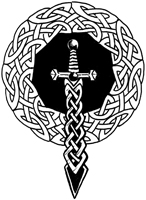
DUBRICIUS
Dyfrig, also known by his Latinized name, Dubricius, was a Dark Age saint. According to Geoffrey of Monmouth’s glamorized version of King Arthur, after Uther’s death, Britons gathered “from their various provinces in the town of Silchester and suggested to Dubricius, the Archbishop of the City of the Legions [Caerleon], that he should crown Arthur, the son of Uther, as their king.”
Dubricius was a real historical figure living in sixth-century post-Roman Britain, and the only bishop to be attached to a city. Today that is normal, but in the Dark Ages bishops were more often unattached. Bishops were usually creatures of their kings, and very much personal appointments. Dubricius consecrated Samson as bishop, apparently as his successor.
DUMNORIX
A chief of the Aedui tribe in Gaul in the first century BC. He fought vigorously against any Gaulish alliance with Julius Caesar. In 54 BC, Caesar chose him as one of the hostages he would take with him on his expedition to Britain, fearing that he would cause trouble if left behind in Gaul. When he failed to argue his way out of this, on the grounds that he suffered from sea-sickness, Dumnorix tried to escape from Caesar’s camp. Caesar sent cavalry after him. Dumnorix was killed, shouting that he was “a free man and a citizen of a free state” (see also Diviciacus).
DUNAWT
See Pabo Post Prydain.
DURATIOS
See Pictones.
DUROTRIGES
A fiercely independent Celtic tribe who resisted the Roman conquest. Their territory coincided with the modern English county of Dorset. Their capital was the magnificent hillfort of Maiden Castle, which was attacked by the Romans and then replaced by a new open town (Dorchester) on lower ground nearby.
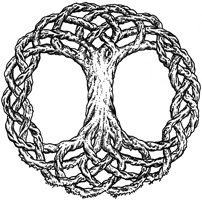
DWELLINGS
The standard dwelling in the Iron Age was a stoutly built round wooden hut with a conical thatched roof and a porch opening to the south-east.
Chysauster in Cornwall, inhabited from about 50 BC to AD 300, was built in a much more ancient tradition. The irregular, fetus-shaped houses with thick, stone-built walls were much more like the stone houses built in Neolithic Orkney hundreds of years earlier. The design was probably partly remembered from an earlier age, and partly a response to a windy, maritime environment.
At Jarlshof in Shetland, the communal memory linking the centuries is made visible. Jarlshof was first inhabited in the Neolithic and continued as a village through the Bronze Age and into the Iron Age, with interruptions when it was engulfed by sand.
Like the Jarlshof houses, the houses at Chysauster were in effect stoutly walled courtyards designed to keep out the wind, with rooms opening out of them. Once there were walled fields round Chysauster, the walls dating from the same time as the village. Thanks to an insane EU subsidy policy, these were plowed up some time ago to make a rocky landscape that is no use for arable or pasture, and its archeology has been destroyed too.
The brochs of Orkney, Shetland, and the Western Isles of Scotland represent a similar design approach—rooms ranged around a courtyard—but carried up into the air to make imposing towers. The finest is the Broch of Mousa, which has survived almost intact because of its inaccessibility on an uninhabited island off the east coast of Shetland. Built in the first century BC and inhabited until about AD 150, it soars 40 feet (10m) above the shore in a graceful drum shape. Timber ranges once lined the interior walls, with galleries at various levels, reached by stone staircases built within the thickness of the outer wall. There was a single door and no windows; it must have been very dark and dank inside.
The hearth was the centerpiece of every dwelling and it had the status of an altar in domestic cult. This custom may have had its roots in the Neolithic; the layout of the stone houses at Skara Brae in Orkney, with large central square hearths, treats the domestic fire almost theatrically.
The Laws of Hywel Dda supply inventories of the objects to be seen in a typical household in early medieval Celtic Britain. They include boilers, blankets, bolsters, coulters, fuel axes (axes for chopping firewood), broad axes, augers, gimlets, firedogs, sickles, baking griddles, trivets, pans, and sieves.
DYFNWAL
Dyfnwal Hen was a king of Alcluith (Clyde), whose fortress was the formidable Dumbarton Rock below Glasgow. His father or grandfather was Ceretic Guletic.
Dyfnwal lived at the end of the fifth century. His grandson was Tutagual Tutclit, and his great-grandson was Riderch, mentioned by St. Adomnán as ruler of the Rock of Clyde. From another son of Dyfnwal descends a long line of recorded kings of Strathclyde, right down to the end of the kingdom in the tenth century.
DYFRIG
See Dubricius.

ECONOMY
The Celtic economy was strongly rural in character, with some arable farming and a great many livestock. The Iron Age landscape was a patchwork of small irregular fields and meadows, with scattered round huts separated by substantial areas of dense forest.
By the end of the Bronze Age a particularly hardy form of wheat called spelt and a new hardy type of barley (hulled instead of naked barley) were introduced into Britain. These innovations meant that in the Iron Age a crop could be sown in the autumn and harvested in the spring—before the spring-sowing. The Greek writer Hecateus observed that as early as the sixth century BC the people of Britain reaped two harvests a year.
The fields were irregular in shape, but on average roughly 1 acre (0.4 hectares) in area. It was the size of field that could be plowed in a day by two oxen ambling along at 2 miles (3km) per hour.
The farming year was marked by four major quarter-day festivals, Imbolg, Beltane, Lugnasad, and Samhain.
ELIDYR
A king of South Rheged (Lancashire and Cheshire) who was the son-in-law of King Maelgwn of Gwynedd.
Elidyr landed near Caernarvon in an attempt to take Gwynedd from Rhun, son of Maelgwn, but was killed on the beach. He was apparently not supported by the York or Pennine kings. Instead it was Rhydderch and other northern allies who sailed south to Gwynedd to avenge his death.
Rhun’s half-brother Bridei had become King of the Picts in 555; he was not only Maelgwn’s son but a cousin of Egferth, King of the Bernicians. A kinship alliance of this kind between Gwynedd and Pictland was something of a threat to the security of the Celtic kingdoms in between, Clyde and Rheged.
But Rhydderch’s raid on Gwynedd was unsuccessful and he had to withdraw. Rhun, King of Gwynedd, responded by gathering an army and marching it north, probably by way of York. It was a march of legendary length and duration and the warriors returned to Gwynedd in triumph.

ELISEG
A king of Powys, commemorated on the Pillar of Eliseg. The inscription, as read by Edward Lhuyd in 1696, is as follows:



